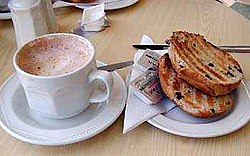Teacake

A toasted English teacake (right) shown with mocha
|
|
| Type | Sweet roll |
|---|---|
| Main ingredients | Dried fruit |
| |
|
A teacake in England is a light yeast-based sweet bun containing dried fruit, typically served toasted and buttered. In the U.S. teacakes can be cookies or small cakes. In Sweden they are soft round flat wheat breads made with milk and a little sugar, and used to make sandwiches, with butter, and for example ham and/or cheese. In India and Australia a teacake is more like a sponge cake. Tea refers to the popular beverage to which these baked goods are an accompaniment.
In most of England, a teacake is a light, sweet, yeast-based bun containing dried fruits, most usually currants, sultanas or peel. It is typically split, toasted, buttered, and served with tea. It is flat and circular, with a smooth brown upper surface and a somewhat lighter underside. Although most people refer to a teacake as a cake containing fruit, in East Lancashire, certain areas of Yorkshire and Cumbria the name currant teacake is used to distinguish fruited 'cakes' from plain bread rolls. In West Yorkshire, a large plain white or brown teacake 9 inches or 225 mm diameter is often also called a breadcake and is used to make very large sandwiches. Many cafes sell these for breakfast or midmorning snacks. In Kent, the teacake is known as a "huffkin", which is often flavoured with hops, especially at the time of harvesting hops in September. In Sussex, a luxurious version of the teacake with added aromatics such as nutmeg, cinnamon and rose water is still sometimes made and called a manchet or Lady Arundel's Manchet.
In East Lancashire, the former West Riding of Yorkshire and elsewhere in the North like the town of Barnsley, a teacake is a round bread roll which is cut in half to make sandwiches. They do not usually contain any sort of dried fruit. They can be made with either white, brown, wholemeal, or Granary flour (a brand of flour produced by Hovis, made by malting wheat, crushing the grains, roasting them, and then mixing them with brown flour). A favourite way to eat them is to slice them into fingers, toast and then spread with butter and Bovril or Marmite.
...
Wikipedia
